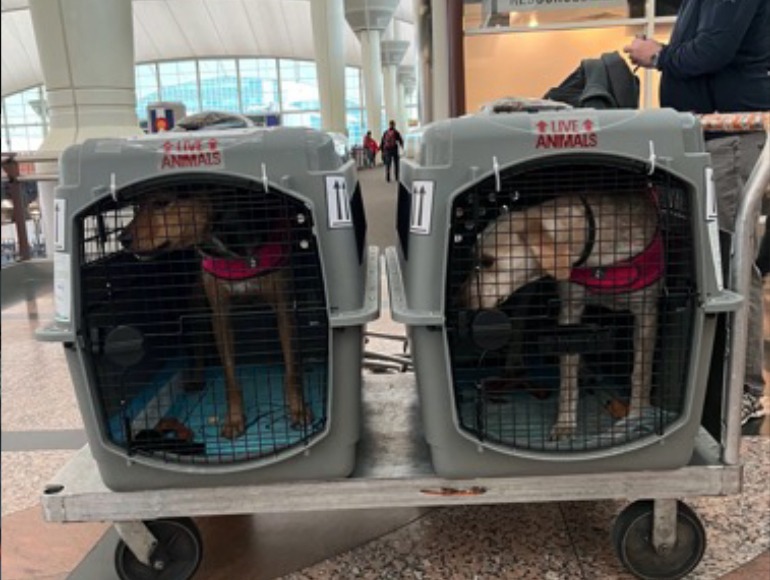Navigating The Wild Blue Yonder — Flying with Pets

By Margaret Cate, volunteer writer
Former League volunteer Jennifer Rider and her husband recently relocated to Germany for a new job opportunity. When faced with the possibility of the move, they were also met with the daunting task of transporting their beloved fur babies, two 60-pound rescues, a German shepherd mix and a coon hound, to a foreign country. With an average price of $3,000 per trip, dedicated pet transport services proved to be cost prohibitive, but Jennifer discovered that her dogs could fly as “excess baggage” in cargo. Due to the pandemic, space was at a premium, but she managed to secure two spots for her pups.
Airlines require that all animals in cargo travel in crates that have hard plastic, versus wire, walls. Jennifer’s dogs were unaccustomed to this type of crate, so she began introducing them to their new environments two months prior to the flight. Training was a slow process, but the dogs gradually felt more comfortable spending longer periods of time in the travel crates as they learned to play, eat, and sleep in them.
“Animals who do not regularly practice and build positive associations with confinement will very likely experience an increase in their stress levels during air travel,” explained Jess Cytron, Director of Shelter Behavior & Veterinary Services at the Dumb Friends League. “I recommend practicing using a crate or carrier with your pet to proactively build a positive association with a confined space – feed meals in the crate or carrier, [provide] special treats, practice just enjoying calm time in the confined space with the human present nearby.”
A staff member from the Dumb Friends League also suggested that Jennifer purchase ThunderShirts, so the dogs began wearing them around the same time that the new crates were introduced. As the departure date grew closer, she consulted with her veterinarian about natural remedies and homeopathic solutions that might further calm the dogs on the long flight.
“I recommend that pet owners speak with their veterinarian about potentially using supplements or medications to help proactively reduce stress for animals during air travel. Everything from busy airports, shuttles, [and] the flight itself can feel very new and triggering for an animal, and it is difficult to predict how well or how poorly an animal may tolerate that experience,” said Cytron. “Make sure to have an established relationship with a veterinarian before ever traveling with your pet!”
Jennifer’s last hurdle before the trip was to provide a certificate for travel from a USDA-approved veterinarian within 10 days of arrival in Germany. The certificate ensured that all relevant vaccinations were up to date. With two months of careful preparation, Jennifer reported that her dogs handled the international flight very well. Her advice for would-be travelers? “Know where you’re going and plan in advance. Traveling in cargo is not a last minute decision.”



